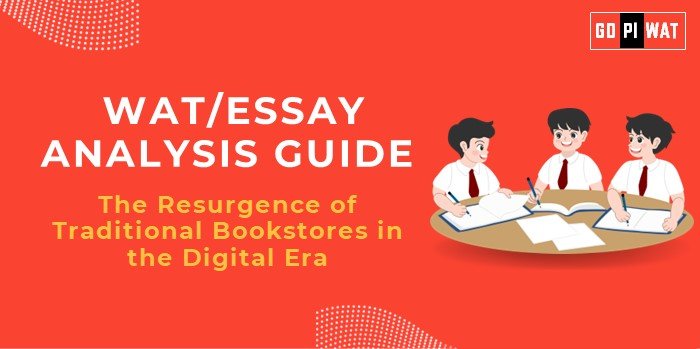📋 WRITTEN ABILITY TEST (WAT)/ESSAY ANALYSIS GUIDE
🌐 Understanding the Topic’s Importance
This topic bridges retail strategies and consumer behavior, offering B-school candidates a chance to discuss market adaptation and sustainability in a digital economy.
⏳ Effective Planning and Writing
- Time Allocation:
- 📝 Planning: 5 minutes
- ✍️ Writing: 20 minutes
- 🔍 Review: 5 minutes
- Preparation Tips:
- 📊 Note key statistics on consumer behavior and retail trends.
- 🔍 Highlight both consumer trends and industry challenges.
💡 Introduction Techniques for Essays
-
- Contrast Approach:
“As e-commerce dominates the retail landscape, the unexpected revival of traditional bookstores points to a shift in consumer values.”
-
- Solution-Based Approach:
“Amid the digital surge, traditional bookstores are re-emerging as community hubs, offering insights into blending physical and digital strategies.”
-
- Timeline Approach:
“From near extinction in the 2010s to a revival in the 2020s, bookstores are redefining their role in modern retail.”
📖 Structuring the Essay Body
- Achievements:
- 📚 Increased independent bookstore openings, reflecting consumer interest in curated experiences.
- 🏛️ Enhanced role as cultural and community spaces fostering personal connections.
- Challenges with Comparative Analysis:
- ⚠️ High rent and operational costs compared to online platforms with low overhead expenses.
- 📉 Limited scalability in physical models versus the global reach of giants like Amazon.
- Future Outlook:
- 🛍️ Embracing hybrid models where bookstores integrate e-commerce capabilities.
- 🤝 Focusing on community-driven growth through unique experiences like book clubs and events.
- 💡 Collaborating with local authors and artists to diversify offerings and attract niche audiences.
📄 Concluding Effectively
-
- Balanced Perspective:
“Traditional bookstores are carving a niche in an increasingly digital world, combining the charm of physical spaces with modern consumer expectations.”
-
- Global Example Comparison:
“Like Japan’s Tsutaya model, bookstores worldwide must innovate to thrive in the digital age.”
📊 Analyzing Successes and Shortcomings
- Key Achievements:
- ✅ Increased community engagement through cultural events and local partnerships.
- 📈 Growth in niche markets catering to specific interests and demographics.
- Ongoing Challenges:
- ⚠️ Competition with digital media platforms offering convenience and vast inventories.
- 💸 Cost pressures from high rents and limited scalability of physical stores.
- Global Context:
- 🇪🇪 Mixed success in digital-first economies like Estonia.
- 🇯🇵 Japan’s Tsutaya model shows the value of transforming bookstores into multi-functional cultural hubs.
🚀 Recommendations for Sustainable Progress
- 📣 Focus on Community Engagement: Build unique experiences like book signings, clubs, and cultural events.
- 📈 Integrate Digital Tools: Use e-commerce platforms for inventory management and online sales.
- 🎨 Collaborate with Local Talent: Partner with authors and artists to diversify offerings and attract niche audiences.
✍️ Sample Short Essays
-
- Balanced Perspective:
“Traditional bookstores’ revival underscores the timeless appeal of personal connection and curated experiences, even as e-commerce dominates. Their future lies in blending physical charm with digital adaptability.”
-
- Solution-Oriented:
“Hybrid models combining the physical charm of bookstores with digital tools may ensure their sustainability in a tech-driven era.”
-
- Global Comparison:
“Drawing inspiration from Japan’s Tsutaya, bookstores can transform into multi-functional spaces to thrive alongside digital competitors.”


